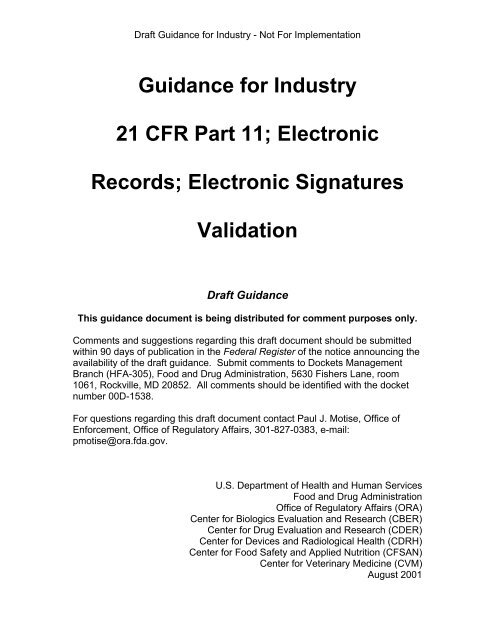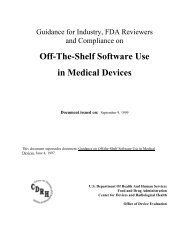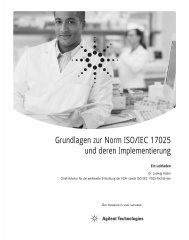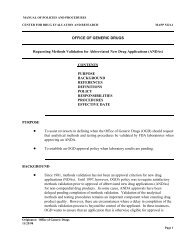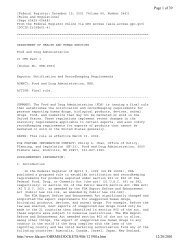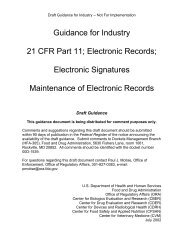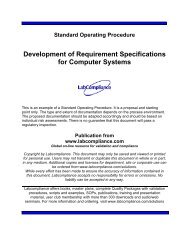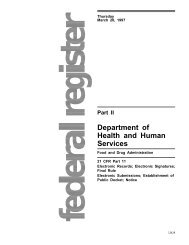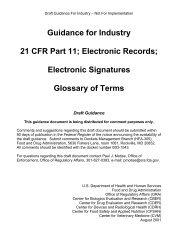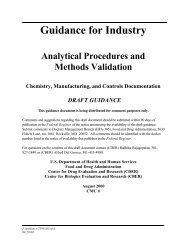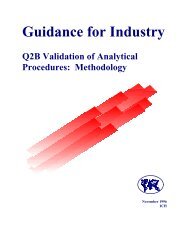21 CFR Part 11: Validation - Food and Drug Administration
21 CFR Part 11: Validation - Food and Drug Administration
21 CFR Part 11: Validation - Food and Drug Administration
You also want an ePaper? Increase the reach of your titles
YUMPU automatically turns print PDFs into web optimized ePapers that Google loves.
Draft Guidance for Industry - Not For ImplementationGuidance for Industry<strong>21</strong> <strong>CFR</strong> <strong>Part</strong> <strong>11</strong>; ElectronicRecords; Electronic Signatures<strong>Validation</strong>Draft GuidanceThis guidance document is being distributed for comment purposes only.Comments <strong>and</strong> suggestions regarding this draft document should be submittedwithin 90 days of publication in the Federal Register of the notice announcing theavailability of the draft guidance. Submit comments to Dockets ManagementBranch (HFA-305), <strong>Food</strong> <strong>and</strong> <strong>Drug</strong> <strong>Administration</strong>, 5630 Fishers Lane, room1061, Rockville, MD 20852. All comments should be identified with the docketnumber 00D-1538.For questions regarding this draft document contact Paul J. Motise, Office ofEnforcement, Office of Regulatory Affairs, 301-827-0383, e-mail:pmotise@ora.fda.gov.U.S. Department of Health <strong>and</strong> Human Services<strong>Food</strong> <strong>and</strong> <strong>Drug</strong> <strong>Administration</strong>Office of Regulatory Affairs (ORA)Center for Biologics Evaluation <strong>and</strong> Research (CBER)Center for <strong>Drug</strong> Evaluation <strong>and</strong> Research (CDER)Center for Devices <strong>and</strong> Radiological Health (CDRH)Center for <strong>Food</strong> Safety <strong>and</strong> Applied Nutrition (CFSAN)Center for Veterinary Medicine (CVM)August 2001
Draft Guidance for Industry - Not For ImplementationGuidance For Industry<strong>21</strong> <strong>CFR</strong> <strong>Part</strong> <strong>11</strong>; Electronic Records;Electronic Signatures<strong>Validation</strong>Additional copies of this draft guidance document are available from the Office ofEnforcement, HFC-200, 5600 Fishers Lane, Rockville, MD 20857; Internethttp://www.fda.gov/ora/compliance_ref/part<strong>11</strong>.htmU.S. Department of Health <strong>and</strong> Human Services<strong>Food</strong> <strong>and</strong> <strong>Drug</strong> <strong>Administration</strong>Office of Regulatory Affairs (ORA)Center for Biologics Evaluation <strong>and</strong> Research (CBER)Center for <strong>Drug</strong> Evaluation <strong>and</strong> Research (CDER)Center for Devices <strong>and</strong> Radiological Health (CDRH)Center for <strong>Food</strong> Safety <strong>and</strong> Applied Nutrition (CFSAN)Center for Veterinary Medicine (CVM)August 2001ii
Draft Guidance for Industry - Not For ImplementationGuidance For Industry<strong>21</strong> <strong>CFR</strong> <strong>Part</strong> <strong>11</strong>; Electronic Records; Electronic Signatures<strong>Validation</strong>Table of Contents1. Purpose .........................................................................................................12. Scope ............................................................................................................12.1 Applicability ................................................................................................22.2 Audience ....................................................................................................33. Definitions <strong>and</strong> Terminology ..........................................................................34. Regulatory Requirements; What Does <strong>Part</strong> <strong>11</strong> Require? ..............................35. Key Principles ................................................................................................45.1 System Requirements Specifications.........................................................45.2 Documentation of <strong>Validation</strong> Activity ..........................................................65.2.1 <strong>Validation</strong> Plan.....................................................................................65.2.2 <strong>Validation</strong> Procedures..........................................................................65.2.3 <strong>Validation</strong> Report ................................................................................65.3 Equipment Installation ................................................................................75.4 Dynamic Testing.........................................................................................75.4.1 Key Testing Considerations .................................................................75.4.2 Software testing should include: ..........................................................85.4.3 How test results should be expressed. ................................................85.5 Static Verification Techniques ....................................................................95.6 Extent of <strong>Validation</strong> ....................................................................................95.7 Independence of Review..........................................................................105.8 Change Control (Configuration Management)..........................................106. Special Considerations ................................................................................<strong>11</strong>6.1 Commercial, Off-The-Shelf Software........................................................<strong>11</strong>6.1.1 End User Requirements Specifications..............................................126.1.2 Software Structural Integrity...............................................................126.1.3 Functional Testing of Software ..........................................................136.2 The Internet..............................................................................................136.2.1 Internet <strong>Validation</strong>..............................................................................13Appendix A - References .................................................................................15iii
Draft Guidance for Industry - Not For ImplementationGuidance For Industry 1<strong>21</strong> <strong>CFR</strong> <strong>Part</strong> <strong>11</strong>; Electronic Records; Electronic Signatures<strong>Validation</strong>This draft guidance, when finalized, will represent the <strong>Food</strong> <strong>and</strong> <strong>Drug</strong><strong>Administration</strong>’s (FDA’s) current thinking on this topic. It does not create or conferany rights for or on any person <strong>and</strong> does not operate to bind FDA or the public. Analternative approach may be used if such approach satisfies the requirements ofapplicable statutes <strong>and</strong> regulations.1. PurposeThe purpose of this draft guidance is to describe the <strong>Food</strong> <strong>and</strong> <strong>Drug</strong> <strong>Administration</strong>'s(FDA’s) current thinking regarding considerations in meeting the validation requirements of<strong>Part</strong> <strong>11</strong> of Title <strong>21</strong> of the Code of Federal Regulations; Electronic Records; ElectronicSignatures. It provides guidance to industry, <strong>and</strong> is intended to assist persons who aresubject to the rule to comply with the regulation. It may also assist FDA staff who applypart <strong>11</strong> to persons who are subject to the regulation.2. ScopeThis draft guidance is one of a series of guidances about part <strong>11</strong>. We intend to provideinformation with respect to FDA's current thinking on acceptable ways of meeting part <strong>11</strong>1 This draft guidance was prepared under the aegis of the Office of Enforcement by the FDA <strong>Part</strong> <strong>11</strong>Compliance Committee. The committee is composed of representatives from each center within the <strong>Food</strong><strong>and</strong> <strong>Drug</strong> <strong>Administration</strong>, the Office of Chief Counsel <strong>and</strong> the Office of Regulatory Affairs.1
Draft Guidance for Industry - Not For Implementationrequirements to ensure that electronic records <strong>and</strong> electronic signatures are trustworthy,reliable, <strong>and</strong> compatible with FDA's public health responsibilities.Electronic record <strong>and</strong> electronic signature systems consist of both manual proceduralcontrols <strong>and</strong> technical controls implemented through computer systems. This draftguidance focuses on validation of computer systems. It identifies key validation principles<strong>and</strong> addresses some frequently asked questions, but it is not intended to cover everythingthat computer systems validation should encompass in the context of electronicrecord/electronic signature systems. You can read more information about computersystems validation in the documents listed in Appendix A - References.2.1 ApplicabilityThis draft guidance applies to electronic records <strong>and</strong> electronic signatures that personscreate, modify, maintain, archive, retrieve, or transmit under any records or signaturerequirement set forth in the Federal <strong>Food</strong>, <strong>Drug</strong>, <strong>and</strong> Cosmetic Act (the Act), the PublicHealth Service Act (PHS Act), or any FDA regulation. Any requirements set forth in theAct, the PHS Act, or any FDA regulation, with the exception of part <strong>11</strong>, are referred to inthis document as predicate rules. Most predicate rules are contained in Title <strong>21</strong> of theCode of Federal Regulations. In general, predicate rules address the research, production,<strong>and</strong> control of FDA regulated articles, <strong>and</strong> fall into several broad categories. Examples ofsuch categories include, but are not limited to, manufacturing practices, laboratory2
Draft Guidance for Industry - Not For Implementationpractices, clinical <strong>and</strong> pre-clinical research, adverse event reporting, product tracking, <strong>and</strong>pre <strong>and</strong> post marketing submissions <strong>and</strong> reports.2.2 AudienceWe intend this draft guidance to provide useful information <strong>and</strong> recommendations to:• Persons subject to part <strong>11</strong>;• Persons responsible for validation of systems used in electronic recordkeeping;• Persons who develop products or services to enable implementation of part <strong>11</strong>requirements; <strong>and</strong>,This draft guidance may also assist FDA staff who apply part <strong>11</strong> to persons subject to theregulation.3. Definitions <strong>and</strong> TerminologyUnless otherwise specified below, all terms used in this draft guidance are defined in FDA’sdraft guidance document, “Guidance For Industry, <strong>21</strong> <strong>CFR</strong> <strong>Part</strong> <strong>11</strong>; Electronic Records;Electronic Signatures, Glossary of Terms,” a document common to the series of guidanceson part <strong>11</strong>.4. Regulatory Requirements; What Does <strong>Part</strong> <strong>11</strong> Require?Section <strong>11</strong>.10 requires persons to “employ procedures <strong>and</strong> controls designed to ensure theauthenticity, integrity, <strong>and</strong>, when appropriate, the confidentiality of electronic records, <strong>and</strong>to ensure that the signer cannot readily repudiate the signed record as not genuine.” To3
Draft Guidance for Industry - Not For Implementationsatisfy this requirement persons must, among other things, employ procedures <strong>and</strong> controlsthat include "[v]alidation of systems to ensure accuracy, reliability, consistent intendedperformance, <strong>and</strong> the ability to discern invalid or altered records."5. Key PrinciplesHere are some key principles you should consider when validating electronic recordkeepingcomputer systems.5.1 System Requirements SpecificationsRegardless of whether the computer system is developed in-house, developed by acontractor, or purchased off-the-shelf, establishing documented end user (i.e., a personregulated by FDA) requirements is extremely important for computer systems validation.Without first establishing end user needs <strong>and</strong> intended uses, we believe it is virtuallyimpossible to confirm that the system can consistently meet them. Once you haveestablished the end user’s needs <strong>and</strong> intended uses, you should obtain evidence that thecomputer system implements those needs correctly <strong>and</strong> that they are traceable to systemdesign requirements <strong>and</strong> specifications. It is important that your end user requirementsspecifications take into account predicate rules, part <strong>11</strong>, <strong>and</strong> other needs unique to yoursystem that relate to ensuring record authenticity, integrity, signer non-repudiation, <strong>and</strong>,when appropriate, confidentiality. For example, as noted above, section <strong>11</strong>.10 has ageneral requirement that persons who use closed systems to create, modify, maintain, ortransmit electronic records must employ procedures <strong>and</strong> controls designed to ensure the4
Draft Guidance for Industry - Not For Implementationauthenticity, integrity, <strong>and</strong>, when appropriate, the confidentiality of electronic records, <strong>and</strong>to ensure that signers cannot readily repudiate signed records as not genuine. In addition,section <strong>11</strong>.30 requires persons who use open systems to employ procedures <strong>and</strong> controlsidentified in section <strong>11</strong>.10, as appropriate; persons who use open systems must alsoimplement special procedures <strong>and</strong> controls, such as document encryption <strong>and</strong> use of digitalsignature st<strong>and</strong>ards, as necessary under the circumstances, to ensure record authenticity,integrity, <strong>and</strong> confidentiality.Other factors not specifically addressed in part <strong>11</strong> may also impact on electronic recordtrustworthiness, integrity <strong>and</strong> system performance. You should consider these factors <strong>and</strong>establish appropriate requirements specifications for them, as well. Here are someexamples:• Scanning processes: where a paper record is scanned to create an electronicrecord, scanner resolution, scanning rates, color fidelity, <strong>and</strong> the type ofhardware interface may impact the accuracy <strong>and</strong> reliability of the electronicrecord as well as system performance.• Scalability: in a networked environment, system performance may be affectedby the number of workstations <strong>and</strong> b<strong>and</strong>width dem<strong>and</strong>s of file size <strong>and</strong> types.• Operating environment: sources of electromagnetic interference, radiofrequency interference, temperature/humidity, <strong>and</strong> electrical powerfluctuations may affect system performance.5
Draft Guidance for Industry - Not For Implementation5.2 Documentation of <strong>Validation</strong> ActivityWe consider thorough documentation to be extremely important to the success of yourvalidation efforts. <strong>Validation</strong> documentation should include a validation plan, validationprocedures, <strong>and</strong> a validation report, <strong>and</strong> should identify who in management is responsiblefor approval of the plan, the procedures <strong>and</strong> the report.5.2.1 <strong>Validation</strong> PlanThe validation plan is a strategic document that should state what is to be done, the scopeof approach, the schedule of validation activities, <strong>and</strong> tasks to be performed. The planshould also state who is responsible for performing each validation activity. The planshould be reviewed <strong>and</strong> approved by designated management.5.2.2 <strong>Validation</strong> ProceduresThe validation procedures should include detailed steps for how to conduct the validation.It should describe the computer system configuration, as well as test methods <strong>and</strong>objective acceptance criteria, including expected outcomes. The procedures should bereviewed <strong>and</strong> approved by designated management.5.2.3 <strong>Validation</strong> ReportThe validation report should document detailed results of the validation effort, including testresults. Whenever possible, test results should be expressed in quantified terms ratherthan stated as “pass/fail.” The report should be reviewed <strong>and</strong> approved by designatedmanagement.6
Draft Guidance for Industry - Not For Implementation5.4.2 Software testing should include:• Structural testing: this testing takes into account the internal mechanism(structure) of a system or component. It is sometimes referred to as “whitebox” testing. Structural testing should show that the software creator followedcontemporary quality st<strong>and</strong>ards (e.g., consensus st<strong>and</strong>ards from national <strong>and</strong>international st<strong>and</strong>ards development organizations, such as those listed inAppendix A of this guidance). This testing usually includes inspection (orwalk-throughs) of the program code <strong>and</strong> development documents.• Functional testing: this testing involves running the program under knownconditions with defined inputs, <strong>and</strong> documented outcomes that can becompared to pre-defined expectations. Functional testing is sometimes called“black box” testing.• Program build testing: this testing is performed on units of code (modules),integrated units of code, <strong>and</strong> the program as a whole.5.4.3 How test results should be expressed.Quantifiable test results should be recorded in quantified rather than qualified (e.g.,pass/fail) terms. Quantified results allow for subsequent review <strong>and</strong> independentevaluation of the test results.8
Draft Guidance for Industry - Not For Implementation5.5 Static Verification TechniquesWhile dynamic testing is an important part of validation, we believe that by using dynamictesting alone it would be virtually impossible to fully demonstrate complete <strong>and</strong> correctsystem performance. A conclusion that a system is validated is also supported bynumerous verification steps undertaken throughout the system development. Theseinclude static analyses such as document <strong>and</strong> code inspections, walk-throughs, <strong>and</strong>technical reviews. Where available, knowledge of these activities <strong>and</strong> their outcomes canhelp to focus testing efforts, <strong>and</strong> help to reduce the amount of system level functionaltesting needed at the user site in order to validate that the software meets the user’s needs<strong>and</strong> intended uses.5.6 Extent of <strong>Validation</strong>When you determine the appropriate extent of system validation, the factors you shouldconsider include (but are not limited to) the following:• The risk that the system poses to product safety, efficacy, <strong>and</strong> quality; note thatproduct means the FDA regulated article (food, human or veterinary drug,biological product, medical device, or radiological product);• The risk that the system poses to data integrity, authenticity, <strong>and</strong> confidentiality;<strong>and</strong>,• The system’s complexity; a more complex system might warrant a morecomprehensive validation effort.9
Draft Guidance for Industry - Not For Implementation5.7 Independence of ReviewIt is a quality assurance tenet that objective self-evaluation is difficult. Therefore, wherepossible, <strong>and</strong> especially for higher risk applications, computer system validation should beperformed by persons other than those responsible for building the system. Twoapproaches to ensuring an objective review are: (1) Engaging a third party; <strong>and</strong>, (2) dividingthe work within an organization such that people who review the system (or a portion of thesystem) are not the same people who built it.5.8 Change Control (Configuration Management)Systems should be in place to control changes <strong>and</strong> evaluate the extent of revalidation thatthe changes would necessitate. The extent of revalidation will depend upon the change’snature, scope, <strong>and</strong> potential impact on a validated system <strong>and</strong> established operatingconditions. Changes that cause the system to operate outside of previously validatedoperating limits would be particularly significant.Contractor or vendor upgrades or maintenance activities, especially when performedremotely (i.e., over a network), should be carefully monitored because they can introducechanges that might otherwise go unnoticed <strong>and</strong> have an adverse effect on a validatedsystem. Examples of such activities include installation of circuit boards that might holdnew versions of “firmware” software, addition of new network elements, <strong>and</strong> software“upgrades”, “fixes” or “service packs.” It is important that system users be aware of such10
Draft Guidance for Industry - Not For Implementationother customizations that they prepare. End users should also be able to validate off-theshelfsoftware by performing all of the following:6.1.1 End User Requirements SpecificationsEnd users should document their requirements specifications relative to part <strong>11</strong>requirements <strong>and</strong> other factors, as discussed above. The end user’s requirementsspecifications may be different from the developer’s specifications. If possible, the enduser should obtain a copy of the developer’s requirements specifications for comparison.6.1.2 Software Structural IntegrityWhere source code is not available for examination, end users should infer the adequacy ofsoftware structural integrity by doing all of the following:• Conducting research into the program’s use history. This research shouldinclude: (1) Identifying known program limitations; (2) evaluating other end userexperiences; <strong>and</strong>, (3) identifying known software problems <strong>and</strong> their resolution;<strong>and</strong>• Evaluating the supplier’s software development activities to determine itsconformance to contemporary st<strong>and</strong>ards. The evaluation should preferably bederived from a reliable audit of the software developer, performed by the enduser’s organization or a trusted <strong>and</strong> competent third party.12
Draft Guidance for Industry - Not For Implementation6.1.3 Functional Testing of SoftwareEnd users should conduct functional testing of software that covers all functions of theprogram that the end user will use. Testing considerations discussed above should beapplied. When the end user cannot directly review the program source code ordevelopment documentation (e.g., for most commercial off-the-shelf software, <strong>and</strong> for somecontracted software,) more extensive functional testing might be warranted than when suchdocumentation is available to the user. More extensive functional testing might also bewarranted where general experience with a program is limited, or the software performanceis highly significant to data/record integrity <strong>and</strong> authenticity. Note, however, we do notbelieve that functional testing alone is sufficient to establish software adequacy.6.2 The InternetWe recognize the exp<strong>and</strong>ing role of the Internet in electronic recordkeeping in the contextof part <strong>11</strong>. Vital records, such as clinical data reports or batch release approvals, can betransmitted from source to destination computing systems by way of the Internet.6.2.1 Internet <strong>Validation</strong>We recognize that the Internet, as computer system, cannot be validated because itsconfiguration is dynamic. For example, when a record is transmitted from source todestination computers, various portions (or packets) of the record may travel along different13
Draft Guidance for Industry - Not For Implementationpaths, a route that neither sender nor recipient can define or know ahead of time. Inaddition, entirely different paths might be used for subsequent transfers.The Internet can nonetheless be a trustworthy <strong>and</strong> reliable communications pipeline forelectronic records when there are measures in place to ensure the accurate, complete <strong>and</strong>timely transfer of data <strong>and</strong> records from source to destination computing systems.<strong>Validation</strong> of both the source <strong>and</strong> destination computing systems (i.e., both ends of theInternet communications pipeline) should extend to those measures. We thereforeconsider it extremely important that those measures are fully documented as part of thesystem requirements specifications, so they can be validated. Examples of such measuresinclude:• Use of digital signature technology to verify that electronic records have notbeen altered <strong>and</strong> that the sender’s authenticity is affirmed.• Delivery acknowledgements such as receipts or separate confirmationsexecuted apart from the Internet (e.g., via fax or voice telephone lines.)14
Draft Guidance for Industry - Not For ImplementationAppendix A - ReferencesMuch has been written about activities that support computer systems validation. You mayfind the following references useful to your validation efforts.<strong>Food</strong> <strong>and</strong> <strong>Drug</strong> <strong>Administration</strong> ReferencesElectronic Records; Electronic Signatures Final Rule, 62 Federal Register 13430 (March20, 1997).Glossary of Computerized System <strong>and</strong> Software Development Terminology, Division ofField Investigations, Office of Regional Operations, Office of Regulatory Affairs, <strong>Food</strong> <strong>and</strong><strong>Drug</strong> <strong>Administration</strong>, August 1995.Guidance for Industry: Computerized Systems Used in Clinical Trials, <strong>Food</strong> <strong>and</strong> <strong>Drug</strong><strong>Administration</strong>, April 1999.Guidance for Industry <strong>and</strong> for FDA Staff: General Principles of Software <strong>Validation</strong>, Centerfor Devices <strong>and</strong> Radiological Health, <strong>Food</strong> <strong>and</strong> <strong>Drug</strong> <strong>Administration</strong>, Draft – June 1997.Guidance for the Content of Pre-market Submissions for Software Contained in MedicalDevices, Office of Device Evaluation, Center for Devices <strong>and</strong> Radiological Health, <strong>Food</strong><strong>and</strong> <strong>Drug</strong> <strong>Administration</strong>, May 1998.Guidance for Industry, FDA Reviewers <strong>and</strong> Compliance on Off-the-Shelf Software Use inMedical Devices, Office of Device Evaluation, Center for Devices <strong>and</strong> Radiological Health,<strong>Food</strong> <strong>and</strong> <strong>Drug</strong> <strong>Administration</strong>, September 1999.Guideline on General Principles of Process <strong>Validation</strong>, Center for <strong>Drug</strong>s <strong>and</strong> Biologics, &Center For Devices <strong>and</strong> Radiological Health, <strong>Food</strong> <strong>and</strong> <strong>Drug</strong> <strong>Administration</strong>, May 1987.Reviewer Guidance for a Pre-Market Notification Submission for Blood EstablishmentComputer Software, Center for Biologics Evaluation <strong>and</strong> Research, <strong>Food</strong> <strong>and</strong> <strong>Drug</strong><strong>Administration</strong>, January 1997Student Manual 1, Course INV545, Computer System <strong>Validation</strong>, Division of HumanResource Development, Office of Regulatory Affairs, <strong>Food</strong> <strong>and</strong> <strong>Drug</strong> <strong>Administration</strong>, 1997.Technical Report, Software Development Activities, Division of Field Investigations, Officeof Regional Operations, Office of Regulatory Affairs, <strong>Food</strong> <strong>and</strong> <strong>Drug</strong> <strong>Administration</strong>, July1987.15
Draft Guidance for Industry - Not For ImplementationOther Government ReferencesW. Richards Adrion, Martha A. Branstad, John C. Cherniavsky. NBS Special Publication500-75, <strong>Validation</strong>, Verification, <strong>and</strong> Testing of Computer Software, Center forProgramming Science <strong>and</strong> Technology, Institute for Computer Sciences <strong>and</strong> Technology,National Bureau of St<strong>and</strong>ards, U.S. Department of Commerce, February 1981.Martha A. Branstad, John C Cherniavsky, W. Richards Adrion, NBS Special Publication500-56, <strong>Validation</strong>, Verification, <strong>and</strong> Testing for the Individual Programmer, Center forProgramming Science <strong>and</strong> Technology, Institute for Computer Sciences <strong>and</strong> Technology,National Bureau of St<strong>and</strong>ards, U.S. Department of Commerce, February 1980.J.L. Bryant, N.P. Wilburn, H<strong>and</strong>book of Software Quality Assurance TechniquesApplicable to the Nuclear Industry, NUREG/CR-4640, U.S. Nuclear RegulatoryCommission, 1987.H. Hecht, et.al., Verification <strong>and</strong> <strong>Validation</strong> Guidelines for High Integrity Systems.NUREG/CR-6293. Prepared for U.S. Nuclear Regulatory Commission, 1995.Patricia B. Powell, Editor. NBS Special Publication 500-98, Planning for Software<strong>Validation</strong>, Verification, <strong>and</strong> Testing, Center for Programming Science <strong>and</strong> Technology,Institute for Computer Sciences <strong>and</strong> Technology, National Bureau of St<strong>and</strong>ards, U.S.Department of Commerce, November 1982.Patricia B. Powell, Editor. NBS Special Publication 500-93, Software <strong>Validation</strong>,Verification, <strong>and</strong> Testing Technique <strong>and</strong> Tool Reference Guide, Center for ProgrammingScience <strong>and</strong> Technology, Institute for Computer Sciences <strong>and</strong> Technology, NationalBureau of St<strong>and</strong>ards, U.S. Department of Commerce, September 1982.Delores R. Wallace, Roger U. Fujii, NIST Special Publication 500-165, SoftwareVerification <strong>and</strong> <strong>Validation</strong>: Its Role in Computer Assurance <strong>and</strong> Its Relationship withSoftware Project Management St<strong>and</strong>ards, National Computer Systems Laboratory,National Institute of St<strong>and</strong>ards <strong>and</strong> Technology, U.S. Department of Commerce,September 1995.Delores R. Wallace, et.al. NIST Special Publication 500-234, Reference Information forthe Software Verification <strong>and</strong> <strong>Validation</strong> Process. Computer Systems Laboratory, NationalInstitute of St<strong>and</strong>ards <strong>and</strong> Technology, U.S. Department of Commerce, March 1996.Delores R. Wallace, Editor. NIST Special Publication 500-235, Structured Testing: ATesting Methodology Using the Cyclomatic Complexity Metric. Computer SystemsLaboratory, National Institute of St<strong>and</strong>ards <strong>and</strong> Technology, U.S. Department ofCommerce, August 1996.16
Draft Guidance for Industry - Not For ImplementationInternational <strong>and</strong> National Consensus St<strong>and</strong>ardsANSI / ANS-10.4-1987, Guidelines for the Verification <strong>and</strong> <strong>Validation</strong> of Scientific <strong>and</strong>Engineering Computer Programs for the Nuclear Industry, American National St<strong>and</strong>ardsInstitute, 1987.IEEE Std 1012-1986, Software Verification <strong>and</strong> <strong>Validation</strong> Plans, Institute for Electrical <strong>and</strong>Electronics Engineers, 1986.IEEE St<strong>and</strong>ards Collection, Software Engineering, Institute of Electrical <strong>and</strong> ElectronicsEngineers, Inc., 1994. ISBN 1-55937-442-X.ISO 9000-3:1997, Quality management <strong>and</strong> quality assurance st<strong>and</strong>ards - <strong>Part</strong> 3:Guidelines for the application of ISO 9001:1994 to the development, supply, installation <strong>and</strong>maintenance of computer software. International Organization for St<strong>and</strong>ardization, 1997.ISO/IEC 1<strong>21</strong>19:1994, Information technology – Software packages – Quality requirements<strong>and</strong> testing, Joint Technical Committee ISO/IEC JTC 1, International Organization forSt<strong>and</strong>ardization <strong>and</strong> International Electrotechnical Commission, 1994.ISO/IEC 12207:1995, Information technology – Software life cycle processes, JointTechnical Committee ISO/IEC JTC 1, Subcommittee SC 7, International Organization forSt<strong>and</strong>ardization <strong>and</strong> International Electrotechnical Commission, 1995.ISO/IEC 14598:1999, Information technology – Software product evaluation, JointTechnical Committee ISO/IEC JTC 1, Subcommittee SC 7, International Organization forSt<strong>and</strong>ardization <strong>and</strong> International Electrotechnical Commission, 1999.Software Considerations in Airborne Systems <strong>and</strong> Equipment Certification. SpecialCommittee 167 of RTCA. RTCA Inc., Washington, D.C. Tel: 202-833-9339. DocumentNo. RTCA/DO-178B, December 1992.Production Process Software ReferencesThe Application of the Principles of GLP to Computerized Systems, EnvironmentalMonograph #<strong>11</strong>6, Organization for Economic Cooperation <strong>and</strong> Development (OECD),1995.George J. Grigonis, Jr., Edward J. Subak, Jr., <strong>and</strong> Michael Wyrick, “<strong>Validation</strong> KeyPractices for Computer Systems Used in Regulated Operations,” PharmaceuticalTechnology, June 1997.Guide to Inspection of Computerized Systems in <strong>Drug</strong> Processing, Reference Materials<strong>and</strong> Training Aids for Investigators, Division of <strong>Drug</strong> Quality Compliance, Associate Directorfor Compliance, Office of <strong>Drug</strong>s, National Center for <strong>Drug</strong>s <strong>and</strong> Biologics, & Division of17
Draft Guidance for Industry - Not For ImplementationField Investigations, Associate Director for Field Support, Executive Director of RegionalOperations, <strong>Food</strong> <strong>and</strong> <strong>Drug</strong> <strong>Administration</strong>, February 1983.Daniel P. Olivier, “Validating Process Software”, FDA Investigator Course: MedicalDevice Process <strong>Validation</strong>, <strong>Food</strong> <strong>and</strong> <strong>Drug</strong> <strong>Administration</strong>.GAMP Guide For <strong>Validation</strong> of Automated Systems in Pharmaceutical Manufacture,VersionV3.0, Good Automated Manufacturing Practice (GAMP) Forum, March 1998:Volume 1, <strong>Part</strong> 1: User Guide<strong>Part</strong> 2: Supplier GuideVolume 2: Best Practice for User <strong>and</strong> Suppliers.Technical Report No. 18, <strong>Validation</strong> of Computer-Related Systems. PDA Committee on<strong>Validation</strong> of Computer-Related Systems. PDA Journal of Pharmaceutical Science <strong>and</strong>Technology, Volume 49, Number 1, January-February 1995 Supplement.<strong>Validation</strong> Compliance Annual 1995, International <strong>Validation</strong> Forum, Inc.General Software Quality ReferencesBoris Beizer, Black Box Testing, Techniques for Functional Testing of Software <strong>and</strong>Systems, John Wiley & Sons, 1995. ISBN 0-471-12094-4.Boris Beizer, Software System Testing <strong>and</strong> Quality Assurance, International ThomsonComputer Press, 1996. ISBN 1-85032-8<strong>21</strong>-8.Boris Beizer, Software Testing Techniques, Second Edition, Van Nostr<strong>and</strong> Reinhold, 1990.ISBN 0-442-20672-0.Richard Bender, Writing Testable Requirements, Version 1.0, Bender & Associates, Inc.,Larkspur, CA 94777, 1996.Silvana Castano, et.al., Database Security, ACM Press, Addison-Wesley PublishingCompany, 1995. ISBN 0-201-59375-0.Computerized Data Systems for Nonclinical Safety Assessment, Current Concepts <strong>and</strong>Quality Assurance, <strong>Drug</strong> Information Association, Maple Glen, PA, September 1988.M. S. Deutsch, Software Verification <strong>and</strong> <strong>Validation</strong>, Realistic Project Approaches, PrenticeHall, 1982.Robert H. Dunn <strong>and</strong> Richard S. Ullman, TQM for Computer Software, Second Edition,McGraw-Hill, Inc., 1994. ISBN 0-07-018314-7.18
Draft Guidance for Industry - Not For ImplementationElfriede Dustin, Jeff Rashka, <strong>and</strong> John Paul, Automated Software Testing – Introduction,Management <strong>and</strong> Performance, Addison Wesley Longman, Inc., 1999. ISBN 0-201-43287-0.Robert G. Ebenau, <strong>and</strong> Susan H. Strauss, Software Inspection Process, McGraw-Hill,1994. ISBN 0-07-06<strong>21</strong>66-7.Richard E. Fairley, Software Engineering Concepts, McGraw-Hill Publishing Company,1985. ISBN 0-07-019902-7.Michael A. Friedman <strong>and</strong> Jeffrey M. Voas, Software Assessment - Reliability, Safety,Testability, Wiley-Interscience, John Wiley & Sons Inc., 1995. ISBN 0-471-01009-X.Tom Gilb, Dorothy Graham, Software Inspection, Addison-Wesley Publishing Company,1993. ISBN 0-201-63181-4.Robert B. Grady, Practical Software Metrics for Project Management <strong>and</strong> ProcessImprovement, PTR Prentice-Hall Inc., 1992. ISBN 0-13-720384-5.Janis V. Halvorsen, A Software Requirements Specification Document Model for theMedical Device Industry, Proceedings IEEE SOUTHEASTCON '93, Banking onTechnology, April 4th -7th, 1993, Charlotte, North Carolina.Bill Hetzel, The Complete Guide to Software Testing, Second Edition, A Wiley-QEDPublication, John Wiley & Sons, Inc., 1988. ISBN 0-471-56567-9.Watts S. Humphrey, A Discipline for Software Engineering. Addison-Wesley Longman,1995. ISBN 0-201-54610-8.Watts S. Humphrey, Managing the Software Process, Addison-Wesley PublishingCompany, 1989. ISBN 0-201-18095-2.Capers Jones, Software Quality, Analysis <strong>and</strong> Guidelines for Success, InternationalThomson Computer Press, 1997. ISBN 1-85032-867-6.Stephen H. Kan, Metrics <strong>and</strong> Models in Software Quality Engineering, Addison-WesleyPublishing Company, 1995. ISBN 0-201-63339-6.Cem Kaner, Jack Falk, Hung Quoc Nguyen, Testing Computer Software, Second Edition,Vsn Nostr<strong>and</strong> Reinhold, 1993. ISBN 0-442-01361-2.Craig Kaplan, Ralph Clark, Victor Tang, Secrets of Software Quality, 40 Innovations fromIBM, McGraw-Hill, 1995. ISBN 0-07-9<strong>11</strong>795-3.Edward Kit, Software Testing in the Real World, Addison-Wesley Longman, 1995. ISBN 0-19
Draft Guidance for Industry - Not For Implementation201-87756-2.Alan Kusinitz, “Software <strong>Validation</strong>”, Current Issues in Medical Device Quality Systems,Association for the Advancement of Medical Instrumentation, 1997. ISBN 1-57020-075-0.Michael R. Lyu, Editor, H<strong>and</strong>book of Software Reliability Engineering, IEEE ComputerSociety Press, McGraw-Hill, 1996. ISBN 0-07-039400-8.Steven R. Mallory, Software Development <strong>and</strong> Quality Assurance for the HealthcareManufacturing Industries, Interpharm Press,Inc., 1994. ISBN 0-935184-58-9.Brian Marick, The Craft of Software Testing, Prentice Hall PTR, 1995. ISBN 0-13-1774<strong>11</strong>-5.Glenford J. Myers, The Art of Software Testing, John Wiley & Sons, 1979.ISBN 0-471-04328-1.Daniel Olivier, Conducting Software Audits, Auditing Software for Conformance to FDARequirements, Computer Application Specialists, San Diego, CA, 1994.William Perry, Effective Methods for Software Testing, John Wiley & Sons, Inc. 1995.ISBN 0-471-06097-6.William E. Perry, R<strong>and</strong>all W. Rice, Surviving the Top Ten Challenges of Software Testing,Dorset House Publishing, 1997. ISBN 0-932633-38-2.Roger S. Pressman, Software Engineering, A Practitioner's Approach, Third Edition,McGraw-Hill Inc., 1992. ISBN 0-07-050814-3.Roger S. Pressman, A Manager’s Guide to Software Engineering, McGraw-Hill Inc., 1993ISBN 0-07-050820-8.A. P. Sage, J. D. Palmer, Software Systems Engineering, John Wiley & Sons, 1990.Joc S<strong>and</strong>ers, Eugene Curran, Software Quality, Addison-Wesley Publishing Co., 1994.ISBN 0-201-63198-9.Ken Shumate, Marilyn Keller, Software Specification <strong>and</strong> Design, A Disciplined Approachfor Real-Time Systems, John Wiley & Sons, 1992. ISBN 0-471-53296-7.Dennis D. Smith, Designing Maintainable Software, Springer-Verlag, 1999.ISBN 0-387-98783-5.Ian Sommerville, Software Engineering, Third Edition, Addison Wesley Publishing Co.,1989. ISBN 0-201-17568-1.20
Draft Guidance for Industry - Not For ImplementationKarl E. Wiegers, Creating a Software Engineering Culture, Dorset House Publishing, 1996.ISBN 0-932633-33-1.Karl E. Wiegers, Software Inspection, Improving Quality with Software Inspections,Software Development, April 1995, pages 55-64.Karl E. Wiegers, Software Requirements, Microsoft Press, 1999. ISBN 0-7356-0631-5.DocID <strong>Validation</strong>Draft_PostRES.doc08/29/01<strong>21</strong>


